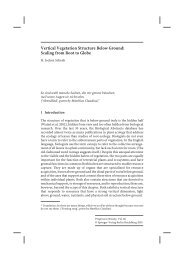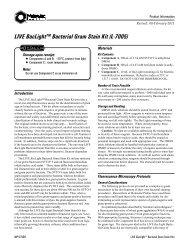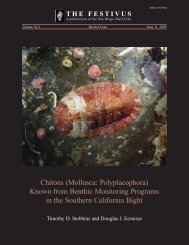Landscape Evolution at an Active Plate Margin - Biological Science ...
Landscape Evolution at an Active Plate Margin - Biological Science ...
Landscape Evolution at an Active Plate Margin - Biological Science ...
You also want an ePaper? Increase the reach of your titles
YUMPU automatically turns print PDFs into web optimized ePapers that Google loves.
Kushiro (1968) was the first to offer <strong>an</strong> expl<strong>an</strong><strong>at</strong>ion<br />
for differences in composition of m<strong>an</strong>tle-derived<br />
basaltic magma. He suggested th<strong>at</strong> depth of melting<br />
was <strong>an</strong> import<strong>an</strong>t variable <strong>an</strong>d th<strong>at</strong> magmas from the<br />
shallow m<strong>an</strong>tle would tend to be quartz norm<strong>at</strong>ive<br />
tholeiites while magmas produced in the deep m<strong>an</strong>tle<br />
would be olivine norm<strong>at</strong>ive <strong>an</strong>d alkaline. Anderson<br />
<strong>an</strong>d Jessey (2005) suggested th<strong>at</strong> one possible expl<strong>an</strong><strong>at</strong>ion<br />
for the DS tholeiites, therefore, was th<strong>at</strong> they<br />
represented a shallower partial melt. This could be<br />
rel<strong>at</strong>ed to their age <strong>an</strong>d/or geographic position to the<br />
west of other Mojave/Owens Valley basalt fields <strong>an</strong>d<br />
nearer shallow remn<strong>an</strong>ts of the east-dipping subduction<br />
zone <strong>an</strong>d East Pacific Rise (Y<strong>an</strong>g, 2002). However,<br />
Brown, Bruns <strong>an</strong>d Jessey (2008) pointed out th<strong>at</strong><br />
this does not account for the presence of iddingsite<br />
which requires preexisting phenocrysts of olivine.<br />
Therefore, initially, DS basaltic magmas may have<br />
been as alkaline as those of other Owens Valley fields<br />
<strong>an</strong>d melting depth might not be <strong>an</strong> import<strong>an</strong>t variable<br />
in compositional difference.<br />
The Cudahy Camp <strong>an</strong>d the Dove Spring form<strong>at</strong>ions<br />
are biostr<strong>at</strong>igraphically import<strong>an</strong>t because they contain<br />
North Americ<strong>an</strong> L<strong>an</strong>d Mammal Age (NALMA)<br />
tr<strong>an</strong>sitions of middle <strong>an</strong>d l<strong>at</strong>e Miocene faunas. The<br />
l<strong>at</strong>e early Miocene Cudahy Camp Form<strong>at</strong>ion is nonfossiliferous,<br />
while the Dove Spring faunas show the<br />
tr<strong>an</strong>sition from the Clarendoni<strong>an</strong> through Hemphilli<strong>an</strong><br />
l<strong>an</strong>d mammal age (13.4–7.3 Ma; Burb<strong>an</strong>k <strong>an</strong>d<br />
Whistler, 1987; Loomis <strong>an</strong>d Burb<strong>an</strong>k, 1988; Whistler,<br />
1991). Research in the local str<strong>at</strong>igraphic sequence<br />
presents biostr<strong>at</strong>igraphic, magnetostr<strong>at</strong>igraphic <strong>an</strong>d<br />
tephrochronologic age parameters (Whistler <strong>an</strong>d Burb<strong>an</strong>k,<br />
1992) th<strong>at</strong> c<strong>an</strong> be compared to other sedimentary<br />
sections across the continent (Tedford <strong>an</strong>d others,<br />
2004). This str<strong>at</strong>igraphic section contains lithologic<br />
clasts th<strong>at</strong> rel<strong>at</strong>e it to nearby tectonic events. Previous<br />
work suggested th<strong>at</strong> clasts from the rising Sierra Nevada<br />
Mountains were present in <strong>an</strong> upper portion of<br />
the section th<strong>at</strong> d<strong>at</strong>es between 8.5–8.4 Ma (Whistler<br />
<strong>an</strong>d Burb<strong>an</strong>k, 1992). Current studies (D. P. Whistler,<br />
p. c. to Reynolds, 2008) suggest th<strong>at</strong> “Sierr<strong>an</strong>-looking<br />
gr<strong>an</strong>itic clasts in place” have been found in a portion<br />
of the section above Ash 15 along the Powerline Road<br />
west of the campground th<strong>at</strong> d<strong>at</strong>es to 9.4 m.y. associ<strong>at</strong>ed<br />
with the Dove Spring Local Fauna. This suggests th<strong>at</strong><br />
gr<strong>an</strong>ites of the Sierra Nevada geologic province were<br />
exposed by 9 Ma.<br />
Return to vehicles <strong>an</strong>d RETRACE EAST to CA 14.<br />
D. R. Jessey <strong>an</strong>d R. E. Reynolds<br />
59.8 (1.0) W<strong>at</strong>ch for cross traffic. TURN LEFT<br />
(north) on CA 14. Note the brightly colored outcrops<br />
of west-northwest dipping Ricardo Group lacustrine<br />
<strong>an</strong>d fluvial sedimentary layers as you drive north on<br />
CA 14. The prominent ridge-capping black rocks are<br />
basalt flows within the Ricardo Group.<br />
63.3 (3.5) Continue past a left turn to Dove Spring<br />
offroad vehicle area. Pleistocene terrace deposits crop<br />
out along Dove Spring Wash. These sediments represent<br />
deposition of a bajada between the Sierra Nevada<br />
R<strong>an</strong>ge <strong>an</strong>d the El Paso Mountains, <strong>an</strong>d were dissected<br />
when erosion breached the fault complex along the<br />
south side of the El Paso Mountains. Sediments contain<br />
small <strong>an</strong>d large mammal species including Bison,<br />
the R<strong>an</strong>cholabre<strong>an</strong> indic<strong>at</strong>or mammal, <strong>an</strong>d have<br />
produced C-14 d<strong>at</strong>es between 19–10 ka (Whistler,<br />
1990, 1991).<br />
64.4 (1.1) Continue past a right (southeast) turn to<br />
Burro Schmidt’s Tunnel <strong>an</strong>d northern access to the El<br />
Paso Mountains. Continue northeast on CA 14.<br />
65.5 (1.1) Divide (el. 3300 ft.) separ<strong>at</strong>es Fremont<br />
Valley drainage system from Indi<strong>an</strong> Wells Valley, the<br />
l<strong>at</strong>ter draining east toward Searles Valley. The Scodie<br />
Mountains of the southern Sierra Nevada are to the<br />
west-northwest. Indi<strong>an</strong> Wells Valley lies <strong>at</strong> <strong>an</strong> elev<strong>at</strong>ion<br />
of 2300+ feet, only 300 feet above Fremont Valley.<br />
Presumably the elev<strong>at</strong>ion difference results from<br />
movement along the El Paso fault, but it could also<br />
be rel<strong>at</strong>ed to tr<strong>an</strong>spression caused by a left step in the<br />
Garlock fault (Smith, 1998).<br />
73.4 (7.8) Pass Robbers Roost gr<strong>an</strong>itic spires <strong>at</strong> 10:00<br />
(Reynolds, 2002).<br />
77.3 (3.9) Continue past a left (west) turn on SR 178<br />
to Walker Pass <strong>an</strong>d Bakersfield. Walker Pass, <strong>at</strong> 5250<br />
ft, is the obvious break in the Sierra. Joseph R Walker<br />
“discovered” this pass in 1834 leading the Bonneville<br />
expedition, the first wagon train to CA; it was l<strong>at</strong>er<br />
used by Frémont in 1845. The pass became a major<br />
route from gold fields <strong>at</strong> Keysville <strong>an</strong>d Kernville to<br />
Mojave <strong>an</strong>d north to Reno (Pracchia, 1994).<br />
77.7 (0.4) Continue past Bowm<strong>an</strong> Road on the right<br />
(El: 3700 ft.). Look uphill <strong>at</strong> 9:00 to see creosote rings.<br />
These rings are clones of the original pl<strong>an</strong>t, <strong>an</strong>d the<br />
largest rings is 60 ft. in diameter <strong>an</strong>d the pl<strong>an</strong>t is estim<strong>at</strong>ed<br />
to be <strong>at</strong> least 9000 years old.<br />
80.2 (2.5) Continue past a right (east) turn on SR 178<br />
to Inyokern <strong>an</strong>d Ridgecrest (El: 2310 ft.). Magnolia,<br />
siding 16 (Inyokern) <strong>an</strong>d Brown, siding 18, on the<br />
14 2009 Desert Symposium
















